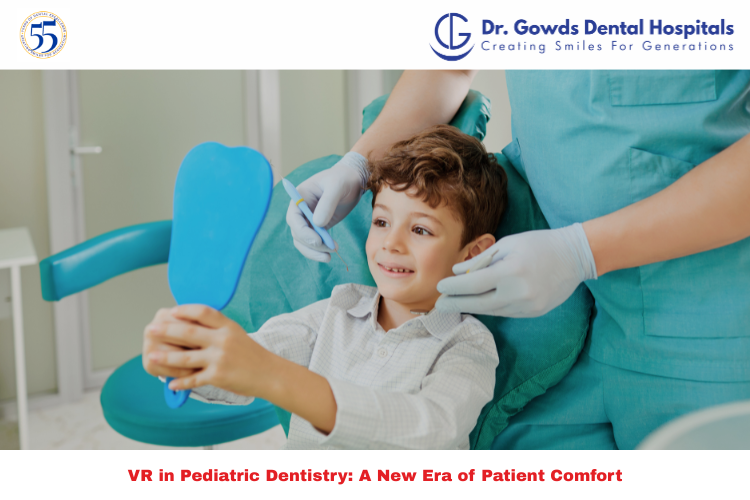Schedule Appointment




At Dr. Gowd’s Dental Hospital, we’ve always believed that children deserve not only the best dental care—but also a caring, positive, and even enjoyable experience. As pediatric dentistry continues to evolve, one emerging technology has gained significant global attention: Virtual Reality (VR). Though not yet widely available in all clinics across India, including ours, VR is quickly becoming a powerful tool for transforming how children experience dental care.
Dental anxiety is incredibly common in kids. Some of the reasons include:
These fears can cause children to cry, refuse treatment, or become extremely distressed—making the dental visit difficult for both families and the dental team.
At Dr. Gowd’s Dental Hospital, we already use many kid-friendly techniques to ease fear, such as behavior guidance, tell-show-do methods, and parental involvement. But globally, a new frontier is showing even more promise: Virtual Reality.
Virtual Reality in dentistry refers to the use of a headset that immerses the child in a soothing and interactive 3D world—such as a calming ocean, a cartoon jungle, or even a space mission. While the dentist works quietly in the background, the child is focused on their immersive VR journey.
It’s a distraction technique—but taken to the next level. Unlike cartoons on a screen, VR engages the child’s full attention by blocking out sights and sounds from the clinic.
Studies have shown that VR can significantly reduce anxiety and stress levels in children undergoing dental procedures. Here’s how:
Globally, VR is being used in a variety of dental scenarios:
VR is not meant to replace expert care or parental reassurance—it simply enhances the experience, making it less scary and more manageable.
Yes. When used correctly, VR is non-invasive and safe for children as young as 4 years old. Sessions are kept short (usually under 30 minutes), and the content is specifically curated to avoid motion sickness or overstimulation.
Headsets are sanitized after each use, and trained staff supervise the child closely throughout. If the child feels uncomfortable at any point, the session can be paused or stopped immediately.
Though VR is not yet standard in Indian dental clinics, it’s being rapidly adopted in global pediatric dental care centers in the U.S., Europe, and UAE. Experts agree that this technology will soon become more accessible in India—especially in progressive dental institutions.
At Dr. Gowd’s Dental Hospital, we are watching this development closely. Our goal has always been to combine compassionate care with modern advancements. While we may not currently offer VR, we are dedicated to exploring innovations that improve pediatric dental experiences, and we remain at the forefront of dental technology in India.
Whether your child is seeing a dentist for the first time or has had a difficult experience in the past, we focus on comfort, communication, and care. Our pediatric dental wing is designed to be child-friendly—from the welcoming environment to the gentle approach of our dental specialists.
And as newer technologies like VR become more available and practical in India, we are committed to adopting the best options for your child’s emotional and dental health.
VR in pediatric dentistry represents a major shift in how we think about dental care for children. While it may not yet be a standard offering in most Indian clinics, its benefits are clear and promising. At Dr. Gowd’s Dental Hospital, we understand that visiting the dentist can be overwhelming for children, and we are constantly striving to make it easier, gentler, and more positive.
Book a pediatric dental consultation today and give your child the kind of care that’s not only clinically excellent—but also emotionally supportive.
While VR is not currently offered at Dr. Gowd’s Dental Hospital, our team actively monitors emerging technologies in pediatric dentistry and remains committed to introducing innovations that improve patient comfort and experience.
Yes. When used under supervision, VR is considered safe for children. Content is age-appropriate, sessions are kept short, and children are monitored throughout to ensure comfort and safety.
VR provides an immersive distraction that removes the child’s focus from dental instruments or sounds. This reduces anxiety, fear, and perceived pain, creating a calmer experience.
Most VR systems are suitable for children aged 4 and above. However, suitability depends on the child’s temperament, comfort with screens, and ability to wear a headset.
Not entirely. VR may reduce the need for mild sedation in anxious children, but it won’t fully replace sedation in cases requiring surgical or complex procedures. It’s a helpful, non-invasive alternative in many cases.